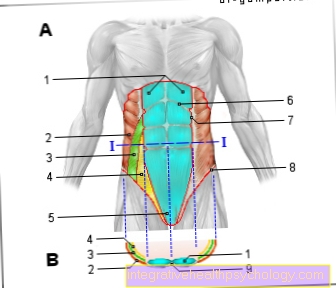Bone cancer

Synonyms in a broader sense
Osteosarcoma, Ewing's sarcoma, chondroma
definition
The term bone cancer refers to the presence of benign (benign) or malicious (malignant) Changes in tissue in the area of the bones.
In addition, there are tumors that cannot be assigned to either group.
These forms of bone cancer are called so-called semimalign (semi-malignant) tumors.
However, these tumors have the property of being able to degenerate further and become malignant.
introduction
In general, such bone tumors (bone cancer) can be divided into two subtypes: primary and secondary bone cancer.
Primary bone cancer develops directly from the bone or cartilage tissue.
This form of bone cancer usually occurs in the affected patients in very similar locations.
Typical localizations (so-called predilection sites) for primary bone tumors are the zones of longitudinal growth (for example the growth plate).
Only the so-called "Ewing sarcoma" is an exception as a primary bone cancer.
This type of bone tumor is found in the majority of cases directly in the area of the Diaphysis.
In addition, primary bone tumors cause symptoms that are rather unspecific for cancer.
Secondary bone cancer, on the other hand, is a subsidiary ulcer (so-called metastasis) that originates from a tumor located in another part of the body.
Secondary bone cancer is particularly common in the spine.
Approximately 80 percent of the causative metastases originate from prostate cancer (prostate cancer), breast cancer (breast cancer), bronchial or renal cell carcinoma.
In a direct comparison between these two forms of bone cancer, it can be assumed that secondary bone tumors are much more common.
Regardless of the particular shape and location of the tumor, most of the affected patients show quite similar symptoms.
Typical signs of cancer of the bone include pain and swelling of the skin and subcutaneous tissue around the affected bone.
In addition, limbs afflicted with bone cancer usually have a marked limitation in their normal range of motion.
In addition, unexplained weight loss, fever and night sweats are typical signs of cancer.
Such complaints do not necessarily have to be related to a malignant tumor. Similar symptoms also occur with other, more harmless diseases.
Nevertheless, people who suffer from persistent bone pain should consult a specialist as soon as possible.
This can determine the underlying cause and initiate appropriate treatment at an early stage.
Read more on the topic: Chondromatosis
causes
The root cause the development of bone cancer is still going on today largely unexplained.
Nevertheless, a large number of cases can be used to demonstrate that certain forms of bone tumors preferably in individual groups of people occur.
The so-called Ewing sarcoma occurs, as does osteosarcoma, preferred by children and adolescents on.
It is now believed that the cause of these two forms of bone cancer is based on genetic factors go back.
In addition, it can be stated that the osteosarcoma in many cases is associated with other diseases.
A classic example of such a disease is the Osteodystrophia deformans (Synonyms: Paget's disease; Paget's disease).
It is a focal disease of the bone tissue, which is characterized by an abnormally increased bone remodeling.
In the affected patients, there are phases that occur Increases in activity single cell types (bone building and degrading cell populations).
As a result, there is one disturbed bone structure and an accompanying one Reduced resilience.
Patients who suffer from Paget's disease usually have a variety of benign tumors from cartilage and bone tissue.
Typical locations of Paget's disease are the thighbones, the pelvic bones, the spine, and the skull bones.
Also previous Radiation therapy and / or chemotherapy can be linked to the development of bone cancer.
According to extensive studies, especially in children, at a young age had cancer increased risk for the occurrence of bone cancer.
Symptoms
The Symptoms which occur in the course of a cancer of the bone are themselves usually quite similar, however, the complaints depending on the exact location of bone cancer, assume other forms.
In the case of bone cancer, the symptoms that arise depend mainly on on the type of tumor and its size.
Especially Pain on the skin and subcutaneous tissue in the Area of the affected bone are among the typical complaints associated with bone cancer.
In addition, it usually occurs in the affected patient significant swelling in the immediate vicinity of the tumor.
Both the pain that occurs and the enormous swelling can lead to the ordinary range of motion clear limited is.
Other complaints differ depending on the type of bone cancer present.

Symptoms of osteosarcoma
In the case of osteosarcoma, which occurs mainly in the Bones of the arms and legs occurs, the symptoms perceived by the patient become apparent especially on the extremities.
The osteosarcoma represents the most common form of bone cancer. Both strong pain, as well as Swelling are among the typical symptoms of this bone tumor.
In addition, the agility of the affected limb as limited.
Due to the tumor-related changes in the bone architecture loses the bone often stability.
As a result, even normal stress or slight external violence can lead to the affected bone breaks.
In such cases one speaks of a pathological Broken bone (technical term: fracture).
Symptoms of Ewing's sarcoma
Ewing's sarcoma is one comparatively rare form of bone cancer in adults.
In children and adolescents however, Ewing's sarcoma represents the second most common tumor in the area of the bony skeleton.
In most cases, the bone cancer forms in the shaft of the long tubular bones (for example, the thighbone or humerus).
In addition, Ewing's sarcoma can often be seen in the pelvic bones.
Patients with this form of bone cancer usually develop it quite early on Pain and swelling that associated with a fever.
Typically, those affected develop a pronounced, general feeling of illness.
Since the Symptoms with Ewing's sarcoma the symptoms of one ordinary inflammation of the bone marrow (see also: Osteomyelitis) very similar, it often takes a long time, especially in adults, before the suspected diagnosis of "Ewing's sarcoma" is made.
in the advanced stage This form of bone cancer tends to metastasize.
Affected patients increasingly lose weight and often feel defeated.
diagnosis

People who suffer from such symptoms should definitely consult a specialist promptly.
The earlier the diagnosis of bone cancer can be made, the better the prognosis.
The Diagnosis if bone cancer is suspected several steps.
At the beginning there is usually one extensive doctor-patient discussion (see: anamnesis) instead. During this conversation, the doctor asks the patient about the symptoms.
Bone pain and swelling in particular play a decisive role in this context.
In addition, the so-called B symptoms (Fever, unexplained weight loss, Night sweats) provide an initial indication of the presence of cancer.
In addition, the doctor asks questions regarding possibly previous illnesses, Allergies and diseases that run in the patient's family happens often.
Because pain in the bone area also by one previous accident the patient should consider whether a strong violence has taken place on the affected body region.
Following the doctor-patient conversation, there is an orientation physical examination instead of.
During this examination, the doctor paid particular attention to Abnormalities in the affected body region.
In addition, if bone cancer is suspected, an X-ray must be taken.
Unevenness or changes in bone density can help solidify the suspected diagnosis.

The diagnosis of suspected bone cancer can also supplemented by the following procedures become:
- ultrasound examination (Sonography)
- Computed tomography (CT)
- magnetic resonance imaging (MRI)
- skeletal scintigraphy
The main purpose of skeletal scintigraphy is to show bone metastases.
With this method, the patient receives a radioactively labeled substance injected by tumor cells increased and saved can be.
These deposits can then be in the recording represent visually.
In addition, a blood test can help diagnose bone cancer to secure.
Certain forms of bone cancer are some blood work changed significantly.
In the case of osteosarcoma, for example, there is an increase in alkaline phosphatase (an enzyme).
However, all of these examination methods can only confirm the suspicion of the presence of a bone tumor.
Ultimately there is only one taking out Tissue sample (so-called biopsy) Certainty.
This procedure involves the doctor using a needle to obtain a sample of the affected bone.
This sample can then be examined for changes in the laboratory.
therapy
The choice of am best appropriate treatment measures in bone cancer depends on both the type and spread of the tumor.
In most cases, a good prognosis can only be achieved by that Combination of several forms of treatment be achieved.
Possible therapy options in the presence of a bone tumor are chemotherapy, Operations and radiation therapy.
Therapy of osteosarcoma
In the most common form of bone cancer, osteosarcoma, surgical removal of the tumor is the first choice of treatment.
Since osteosarcoma is a extremely aggressive form of bone cancer, surgical treatment is usually required combined with chemotherapy become.
In this context it is possible chemotherapy before or after surgery to start.
The main purpose of initiating chemotherapy before removing the bone cancer is Reduction of the tumor.
In contrast, radiation treatment is rarely helpful in the presence of an osteosarcoma.
The reason for this is the fact that this form of bone cancer only slightly sensitive to radiation is.
In addition to the size and spread of the bone cancer, this is the most important factor in choosing the most suitable treatment method Presence of distant metastases really important.
During the surgical removal of the tumor, attempts are now being made amputation the affected limb to avoid.
However, this is only possible if the success of the treatment cannot be increased by amputation.
Therapy of Ewing's sarcoma
Ewing's sarcoma, the second most common bone cancer in children and adolescents, is sensitive to radiation, unlike osteosarcoma.
Because of this, treatment of this form of bone cancer can be done both by means of chemo-, as well as by using a radiotherapy respectively.
In most cases it starts the treatment Ewing's sarcoma with ordinary chemotherapy.
Through the Combination of radiation treatment and chemotherapy can cause bone cancer to grow in the bone marrow area usually controlled become.
For this reason, the forecast in the presence of Ewing's sarcoma in general comparatively good.
However, since this form of bone cancer tends to metastasize (preferably in the lungs), the diagnosis should be made whenever possible asked early and timely appropriate treatment should be initiated.
Course and prognosis
The forecast in the presence of bone cancer depends largely on the Time of diagnosis from.
In addition, play that Age of the affected patient who Shape and size the bone tumor plays a crucial role in this context.
Also the fact whether it is a Primary tumor or a distant metastasis affects both the course and the prognosis.
Osteosarcoma
For a patient with this type of bone cancer, the most important question is whether metastases have already formed.
When the bone cancer no metastases yet should have formed, it can be assumed that about five years after the diagnosis is made, 62 out of 100 people are still alive.
At very early diagnosis and small tissue changes can even affect most of the patients completely recovered.
However, if the bone cancer has already spread in the form of daughter ulcers (metastases), so life expectancy decreases rapidly.
Ewing's sarcoma
In the case of this form of bone cancer, the malignant tumor cells are mainly found in the area of the bone marrow. On the basis of this fact, the prognosis of the affected patients can be significantly improved by initiating chemotherapy early.
In general, it can be assumed that about six to seven in ten people have Ewing's sarcoma longer than five years to survive.
The same applies to this form of bone cancer: The sooner the tumor is diagnosed, the better is the prognosis.
prevention
Bone cancer can not leaning forward become. However, the prognosis can mainly be determined by the early detection of tumor cells.
Precisely for this reason, people who attend initially inconspicuous, but over a longer period of time persistent discomfort suffer urgently Consult a specialist.
In this context, play mainly repeated, in their intensity increasing pain in the arms and / or legs play a crucial role.



.jpg)

























